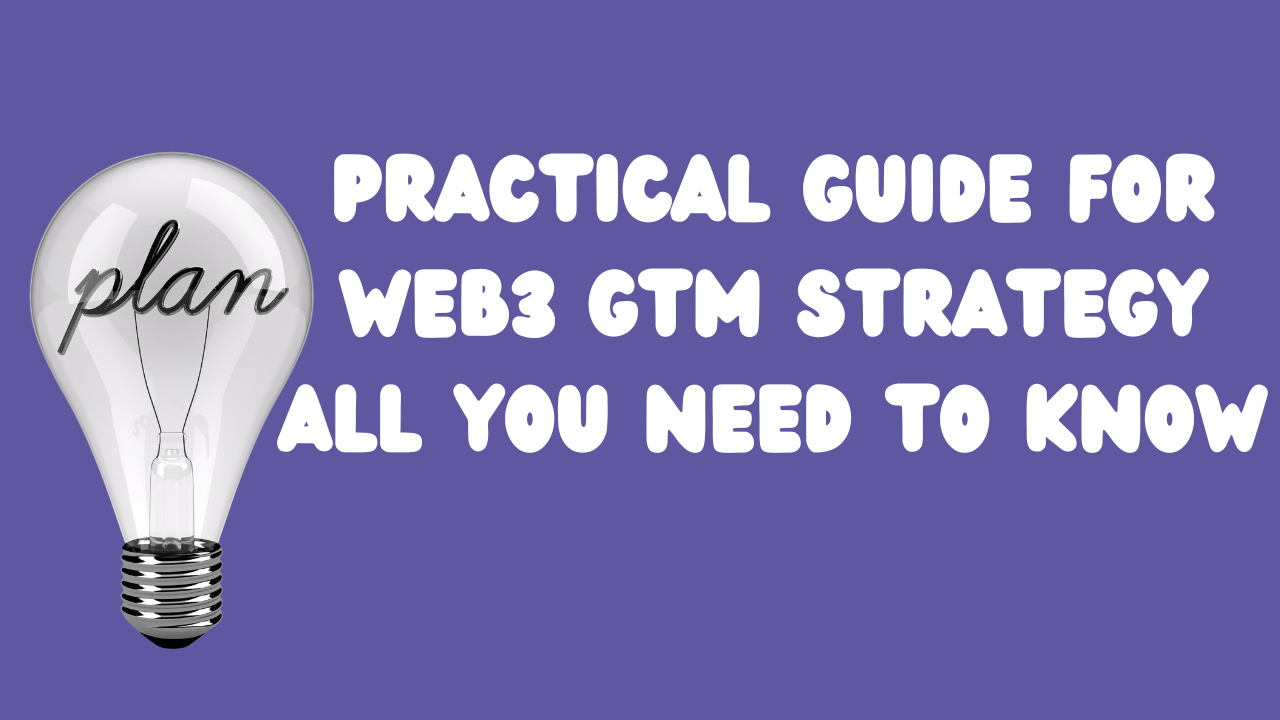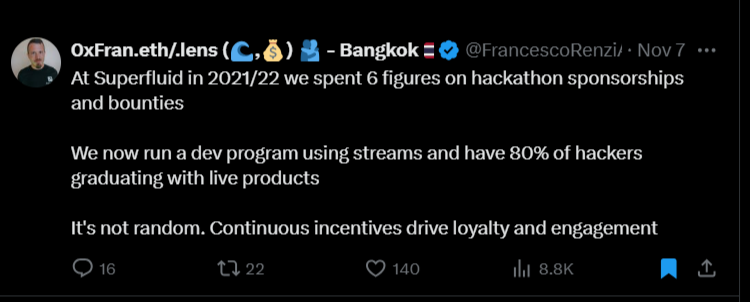Practical Guide for Web3 GTM Strategy: All You Need to Know
 John Fáwọlé
John Fáwọlé
Building a Web3 product, especially a very technical one at that, requires a lot of hard work from engineers, designers, and other departments.
For early-stage startups, there will be days of overnight shipping and a couple of other inconvenient yet necessary sacrifices.
Imagine after putting in this amount of effort, the product doesn't fly. It's painful and utterly demoralizing.
This is the reason GTM Strategy is beyond a buzzword. It's the last step for you to bring the brilliance and value in your crypto product to the world.
I’ve been working as a Web3 technical marketing professional for some time and I've been in early-stage teams that ran GTM strategies. More so, I have also analyzed a couple of successful ones.
If you're planning to go mainnet or launch your Web3 startup, this short blog post is your springboard to bringing your product to the market.
In plan words, what's GTM strategy?
GTM is the short form of go-to-market. It connotes an actionable and realistic plan for a startup or protocol to have a successful launch with primary focus on traction and conversion.
Imagine trying to build an L2, called BRICS L2, to facilitate cross-border transaction among BRICS nation-states. At launch, many leaders in BRICS should know about this product, get interested in its relevance, and start using it. This means there was a successful GTM for the said product.
Now, how BRICS L2 will ensure leaders of BRICS nations know about it, are convinced, and become recurrent users is the whole point of GTM strategy.
You can see go-to-market strategy as a system of marrying a Web3 product with a ready market.
Of course, no protocol will use itself or make itself “rich.” Instead, it's the market it targets that will bring liquidity to it. This is the reason the market part is essential.
By the way, this is not about targeting several markets, but rather the ones that pertain to what you are building and will derive value in being your user.
Back to the BRICS L2 example, it will be pointless if this L2 tries to market itself to degen. Instead, its target market are BRICS states, and particularly their:
parliamentarians
finance & trade ministers
institutions, and so on.
Now that you have a clearer idea of what GTM strategy is all about in the blockchain industry, let's addresss an important question about how to know if your protocol needs it.
What protocols need GTM strategies in Web3?
You need GTM strategy if you have built your MVP and have beta tested.
You should make the market aware of the product you have built, so that there will be hype around it during launch.
Psychology plays a huge role in good startup launches. People will only care about it when they see that a couple of people on Twitter, or whatever other platform, also care about it.
In Web3, protocols generally implement go-to-market plans during:
blockchain mainnet announcement
Token Generation Event (TGE) when users can buy protocol tokens
main product launch
If you are planning to do any of the above activities, you should plan for it to maximize the outcome.
Have you assessed your protocol and confirmed your need this strategy? Let's move on to practical plans.
GTM Strategy Plans
Here are a couple of plans for you to check out and put in your GTM arsenal.
Founders Leading the War
PG wrote an essay entitled “Founder Mode” and its main catechesis is centered around founders being actively present in the day-to-day running of their companies.
Brian Chesky is so vocal about AirBnb; Sam altman for OpenAI. The days of sitting back in the bench and giving commands is over. Well, technically it is not, but if you want to get maximal results, you need to be in the arena.
After careful observation, I discovered quite a good number of Web2 founders get away with not being very actively being the face of their companies. There is something about how Web2 works that excuses this; so you’ll still succeed without it.
However, as you might have guessed, Web3 works quite differently. I have noticed that brands with war-time founders often have successful TGE or GTM strategy.
The actual point so far is that you, as a founder, has to be in the arena as you plan go-to-market; you have to be present.
How can you do this?
be more comfortable with platforms like Twitter, and commit about 30 minutes to yapping; explaining the technical merits of your protocol, taming FUD, and contributing to contemporary discussions in the community
create a podcast or tell Web3 podcasters you want to come on their shows
come to Twitter and engage with your target audience
frequently tweet about your MVP and what people should be excited about
be there in whatever capacity your protocol needs you.
Technical Content Creates Soft-landing
This entire industry is full of very technical solutions, products, and concepts. Meanwhile, everyone’s stages of knowledge differ. I’ve seen a couple of interesting protocols that didn’t get the right traction because folks couldn’t really make meaning of their “high-performant protocol enhanced by FHE-based ZK primitives for multichain sequencing.”
Usually, teams building technical Web3 products working on R & D, and when it is all done, the MVP is a big deal to the them; of course, it is!
However, there is a chasm. The target audience do not always see the big deal in the protocol. Or those who have more advanced knowledge about have burning questions like:
like, so how does it work?
what can I build on it?
how can I build on it?
can this explanation be a bit more technical?
can this explanation be a bit more simplified?
how can I integrate this with my protocol?
This point in customer journey is where technical D2D content comes in. If you are working on an L2, for instance, builders have to know the technical merit of your new chain; what is unique about it?
Meanwhile, potential users might not ask these questions directly, and here is where you need to provide answers ahead.
Create materials such as:
technical whitepapers
technical blogs
explainer videos
animations
high-quality documentation
This will help people grasp the essence of what you are doing, and when some of them do, they get interested into becoming part of your community as you prepare to go-to-market.
Build a Fanatic Community to FUD
You build Web3 products so people can use them; this explains why you shouldn’t be out of touch with the community.
A common mistake inexperienced teams often make is building communities on only incentives and even using bots. Frankly, that’s self-deception.
Users that use your protocol because of what to gain will leave when there is nothing for them, and you don’t need such category in your GTM plans.
Therefore, it is better to build the right audience with the right motives right from the start of things. A common question you might have is, “so how do I create a fanatic community for my GTM plan?”
Two things work: advocacy and vibrance.
First on advocacy, you need to preach your product and be vocal about it; let people know about it and answer their questions. No matter how small, you’ll find a good percentage of your audience who genuinely believe in what you are doing.
Secondly, be vibrant and let the community be vibrant. Welcome initiatives, recognize efforts, and give community members free-hand to contribute to the growth of the protocol.
At the start, the team might be the only advocates, but with time, you’ll have an army. You know you have won the community game when your members are creating authentic hype for your launch or mainnet announcement.
Partnerships Make Your Ecosystem Stronger
Since you want to go-to-market, it is logical to make friends with startups who are already in the market.
Back to the BRICS L2 example, it will need chain abstraction and dev tooling. Therefore, BRICS L2 can create partnerships with chain abstraction protocols, such as Biconomy and Particle Network. This way, more attention is coming to it in the wider ecosystem.
However, there is an extremity here: it is not impressive to partner with every Tom, Dick, and Harry. While some do this for the visibility it brings, it is pointless at the end of the day.
Or what is the point of any partnership that neither boosts your traction or revenue?
On that note, it is better to be selective with your partnerships as you plan your Web3 go-to-market strategy; only lock partnerships with protocols that are indeed relevant and helpful to what you are building.
If you can get your partnership games right, your GTM is more than set for success!
And here is a pro tip: find and hire good Business Developers (BDs).
They are particularly skilled in fostering cross-protocol integrations, which you will find helpful. Moreso, they can take all the calls and lock-in the deals while you focus on building.
By all means, ensure you have made a good number of partners before going mainnet.
Design Tokenomics and List Tokens
First of all, I should put a caveat here: not every Web3 platform or protocol needs a token. You should only do it if there are indeed important gaps that tokens can fix in your architecture.
That said, there is an open secret that Web3 is driven by incentives.
Come to think of it, now that you want to go mainnet, why should everyone be excited about it? There are other chains or platforms they can use, why should they use yours?
This is where incentives come in, and token has proven to be an incredible method of incentivization in this industry.
You should plan to launch a token along with the major announcement of your platform; this will trigger even degens to actively join in building the hype of your launch even though they are FUDing their bags.
In connection to that, plan your token economics well so it can be sustainable. For this, it is always better and worth it to get a tokenomics expert do it for you.
Here is where it gets more interesting, you should get the token listed. However, don’t focus entirely on listing on centralized exchanges as the listing fees are very expensive.
In my conversation with teams planning to push their Web3 platforms to the market, I often advise them to list on DEXes as they are a lot cheaper and more effective.
Come up with Quest Campaigns
RetroBridge is perhaps the only platform I have seen that executed this quite impressively. For context, RetroBridge is a protocol that people can use to bridge assets from one chain to another.
Now, part of their quests included users:
bridging based on amounts to win bounties
bridging from chain A to B to win bounties
inviting n amount of other users who bridge up to n amount to win bounties
If you notice, most of the strategies discussed so far included things to do pre-launch; and all the metrics are primarily on the testnet.
But this is a strategy to kick-off activities mainnet as users will be solving various quests to get bounties. This was how a good number of teams got their first 500 users when they got live.
Once you have this initial number, it becomes easier for others to use the protocol even naturally.
Now, you have to plan this well by setting up quests that matter to the growth of your protocol and watch the community take your GTM strategy to the moon.
Galxe is a platform that you will also find helpful in setting up your quests and campaigns.
Organize Hacker Houses or Virtual Hackathon
If you are launching a blockchain or a Web3 dev tool startup, developers are unequivocally your target audience.
From experience, I have seen that you have a very low chance of getting developers into your Galxe campaign as we are not really degens.
Instead, you get developers interested with things that revolve around building, and hackathons don’t get old!
You might have heard sayings that “hackathons are not effective in Web3.” While they have some elements of truth, they are not entirely true. It all depends on the targeting and execution.
When Base launched its mainnet, it organized Onchain Builders Hackathon where many innovators built applications on Base; some of those projects are conveniently bringing thousands of dollars to the network now.
Wormhole is doing the same thing. You should see this tweet by the founder of Superfluid:

Again, investing in hacker houses and hackathons will be helpful for your GTM strategy and long-term ecosystemic goals of your protocol.
Review and Adjust Your GTM Plans
First of all, I shot a video to explain every strategies I’ve mentioned here, you should watch this if you are the video type:
Moving on, this is the summary of everything discussed so far in this blog: get into the arena, talk to your customers, get them excited about the product you are about to launch.
Marketing is an intelligent endeavor. You shouldn’t take these plans religiously. Take your time to monitor your ideal users and push plans that you believe they will sync with.
At regular intervals, review how the campaigns are going and adjust accordingly. Focus more energy on the plans that are working—or generating results—and double-down on them.
Having said that, Blockchain Alpha is a top Web3 technical content studio with expertise in executing GTM strategies. You should reach out if you need well-experienced hands to handle your Web3 go-to-market plans for you.
Subscribe to my newsletter
Read articles from John Fáwọlé directly inside your inbox. Subscribe to the newsletter, and don't miss out.
Written by

John Fáwọlé
John Fáwọlé
Web3 Technical Writer | Content Lead | Marketing Strategist | For Devs